
Detail of the rear face of the bow of a bow-back Windsor armchair, John Letchworth, Philadelphia, Pa., ca. 1787–1792. Yellow poplar (seat), maple, oak, hickory, and black walnut (arms and arm supports) (microanalysis). H. 37", W. (arms) 20 7/8", D. (seat) 17 3/4". (Courtesy, Winterthur Museum, acc. 57.99.2.)
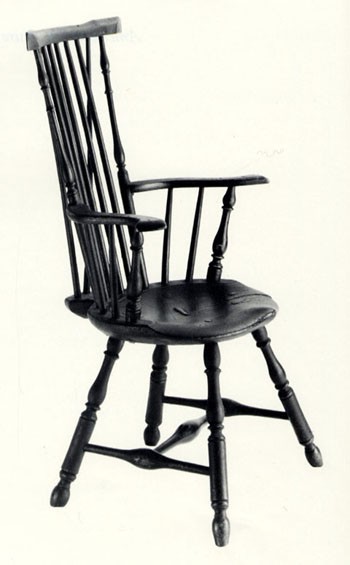
Fan-back Windsor armchair, southeastern Pennsylvania, ca. 1764–1770. Yellow poplar (seat). H. 40 1/2", W. 26 1/2", D. 23 1/4". (Courtesy, Chester County Historical Society, West Chester, Pa.; photo, Winterthur Museum.)

Detail of the seat bottom of the chair illustrated in fig. 2. (Photo, Winterthur Museum.)

Child’s square-back Windsor side chair, George Dewey, Litchfield, Conn., 1815–1824. Basswood (seat, microanalysis). H. 20 1/4", W. (crest) 12 3/4", D. (seat) 12 3/4". (Private collection; photo, Winterthur Museum.)

Sack-back Windsor armchair, Rhode Island, 1780–1790. White pine (seat), maple, oak, and birch (microanalysis). H. 36 13/16", W. (arms) 25 1/4", D. (seat) 15". (Courtesy, Winterthur Museum, acc. 65.836.)
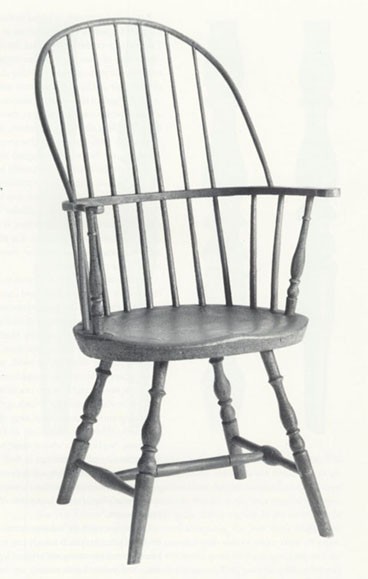
Sack-back Windsor armchair, Connecticut-Rhode Island border region, 1790–1800. White pine (seat), maple, and oak (microanalysis). H. 41 3/4", W. (arms) 24 1/2", D. (seat) 16 1/2". (Courtesy, Winterthur Museum, acc. 65.3027.)

Detail of Windsor chair legs. (Left to right) probably York Co., Pa. (a), and Rhode Island (b–d); 1800–1815, 1785–1790, 1790–1800 (c–d). Maple (legs, microanalysis). H. 38 7/8", 43 7/16", 37 1/2", 39 1/2"; W. (arms) 23 1/2", 24 13/16", 25 1/4", 23 3/16"; D. (seat) 18 3/4", 16", 15 5/8", 15 1/2". (Courtesy, Winterthur Museum, acc. 65.837; 59.1628; 69.230.)
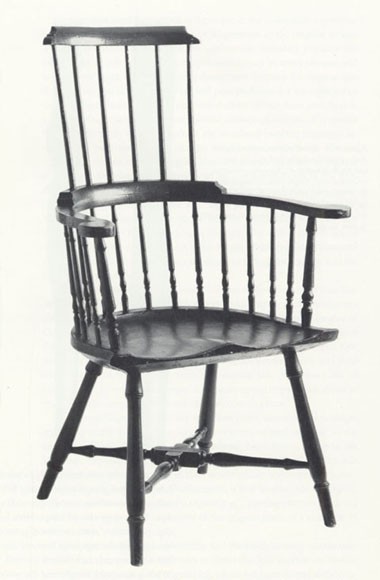
High-back Windsor armchair, Rhode Island, 1760–1770. Maple and ash (microanalysis). H. 42 1/16", W. (arms) 28", D. (seat) 16 1/8". (Courtesy, Winterthur Museum, acc. 65.3025.)

High-back Windsor armchair, Rhode Island, 1760–1770. Maple and hickory (microanalysis). H. 42 7/8", W. (arms) 26 5/8", D. (seat) 21 3/4". (Courtesy, Winterthur Museum, acc. 59.1667.)

Low Windsor stool, New England, 1850–1870. White pine (seat), maple, white pine, and birch (microanalysis). H. 13", W. (seat) 17 3/4", D. (seat) 11 3/8". (Courtesy, Winterthur Museum, acc. 59.1659.)
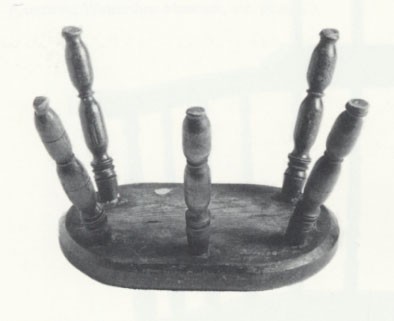
Underside of the stool illustrated in fig. 10. (Photo, Winterthur Museum.)
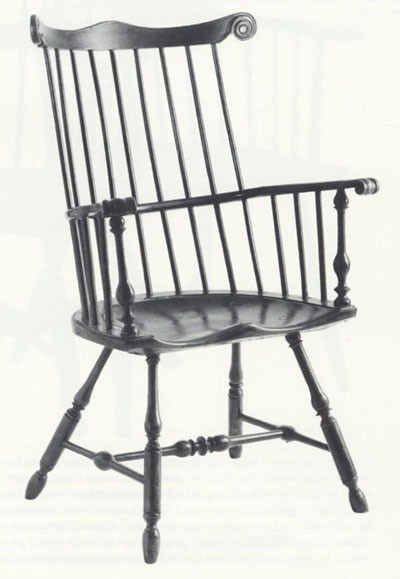
High-back Windsor armchair, Philadelphia, Pa., ca. 1754–1760. Yellow poplar (seat), maple, oak, and ash (microanalysis). H. 42", W. (arms) 28 3/4", D. (seat) 17 3/4". (Courtesy, Winterthur Museum, acc. 59.1572.)

Detail of a crest scroll of a high-back Windsor armchair, Philadelphia, Pa., ca. 1765. Yellow poplar (seat), maple, oak, and hickory. H. 44 5/8", W. (arms) 25 5/8", D. (seat) 16". (Private collection; photo, Winterthur Museum.)
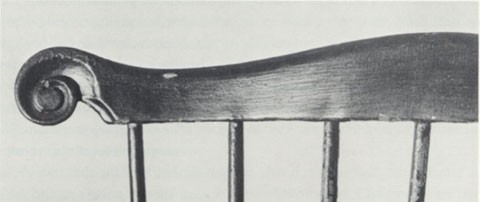
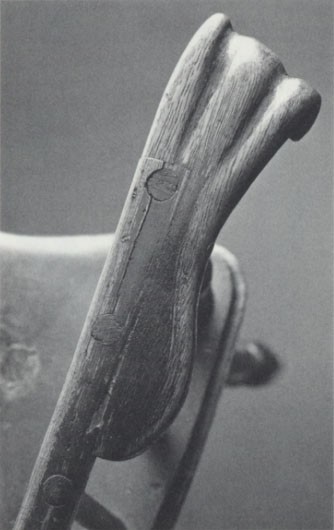
Detail of an arm terminal of the chair illustrated in fig. 12. (Photo, Winterthur Museum.)

Square-back Windsor side chair converted to rocker, Cornelius Timpson and John Vangelder, New York City, 1799–1801. Yellow poplar (seat), maple, and other woods. H. 29
1/2", W. (rockers) 21 1/8", D. (rockers) 21". (Courtesy, Winterthur Museum, acc. 81.41.)
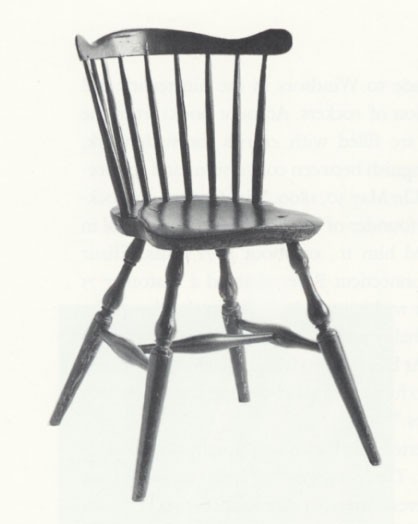
Fan-back Windsor side chair, northeastern coastal Connecticut, 1790–1800. Basswood (seat), maple, and hickory (microanalysis). H. 30 3/8", W. (crest) 18 3/8", D. (seat) 15 7/8". (Courtesy, Winterthur Museum, acc. 59.2081.)
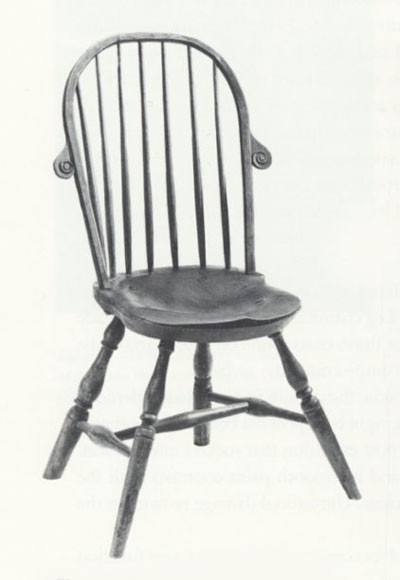
Bow-back Windsor side chair, Connecticut-Rhode Island border region, 1795–1805. Cottonwood (seat), maple, oak, and hickory (microanalysis). H. 34 9/16", W. (seat)
14 5/16", D. (seat) 16 1/2". (Courtesy, Winterthur Museum, acc. 64.1173.)

Detail of the front leg-seat joint of the chair illustrated in fig. 18. (Photo, Winterthur Museum.)

Triple sack-back Windsor settee, eastern Connecticut or Rhode Island, 1790–1805. White pine (seat), maple, oak, and hickory (microanalysis). H. 40 1/2", W. (arms) 81 3/4", D. (seat) 23 5/8". (Courtesy, Winterthur Museum, acc. 59.151.)
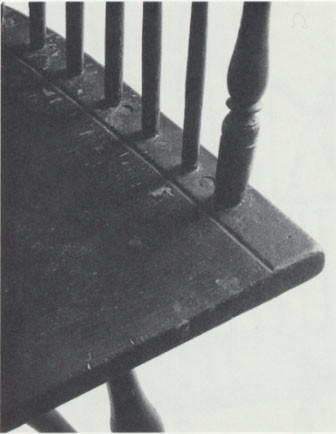
Detail of the right front seat corner and arm supports of the chair illustrated in fig. 20. (Photo, Winterthur Museum.)
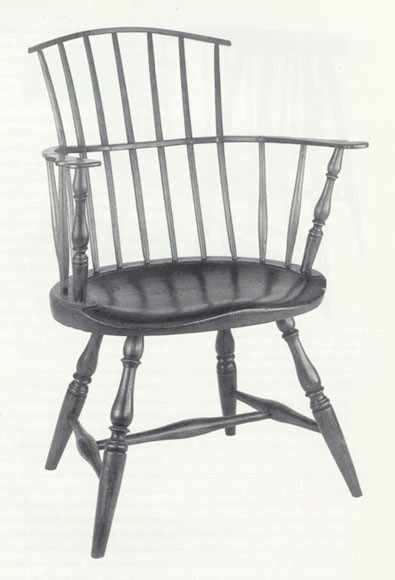
Sack-back Windsor armchair, Connecticut-Rhode Island border region, 1790–1800. Maple, oak, and other woods; dimensions unknown. (Former collection of J. Stogdell Stokes; photo, Philadelphia Museum of Art.)
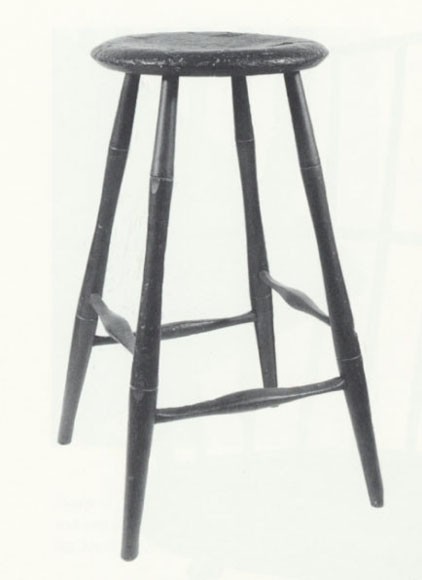
High Windsor stool, eastern United States, probably New England, style of 1795–1810. Basswood (seat) and maple (microanalysis). H. 27 1/2", Diam. (top) 14"–14 1/4". (Courtesy, Winterthur Museum, acc. 58.120.4.)
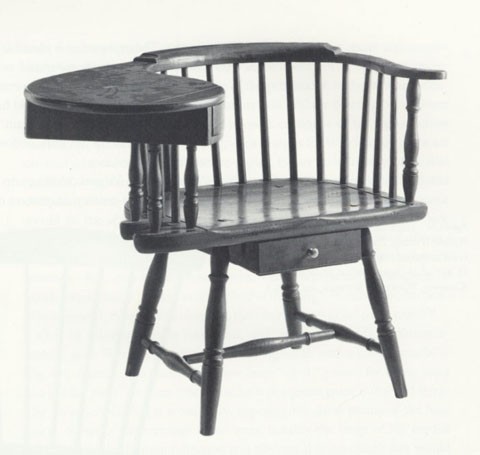
Low-back Windsor writing-arm chair, eastern United States, probably Virginia, possibly nineteenth century in style of ca. 1768–1776. American black walnut and yellow pine (microanalysis). H. 30 1/16", W. (arms)
39 3/8", D. (seat) 18 3/8". (Courtesy, Winterthur Museum, acc. 59.1394.)
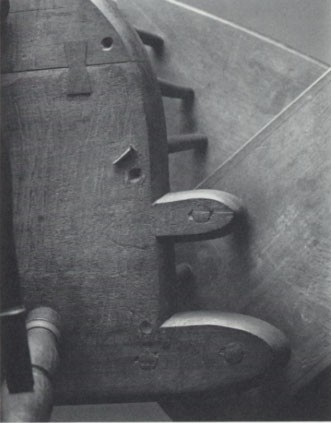
Detail of the seat bottom of the chair illustrated in fig. 24. (Photo, Winterthur Museum.)
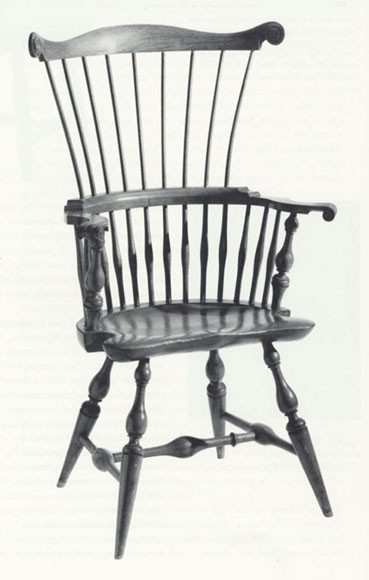
High-back Windsor armchair, Wallace Nutting, Framingham, Massachusetts, 1930s in style of 1780s. Pine (seat) and oak. H.
43 15/16", W. (arms) 26 11/16", D. (seat) 22 1/8". (Courtesy, Winterthur Museum, acc. 77.54.)

Continuous-bow Windsor highchair, Wallace Nutting, Framingham, Mass., 1930s in style of 1790s. White pine (seat), birch, and oak (microanalysis). H. 37", W. (arms) 15 1/8", D. (seat) 12 3/4". (Courtesy, Winterthur Museum, acc. 58.635.)
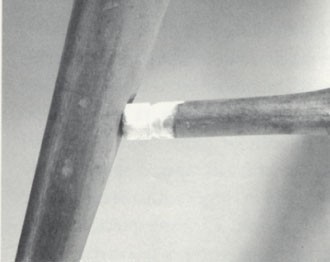
Detail of the leg and stretcher joint of the chair illustrated in fig. 27. (Photo, Winterthur Museum.)
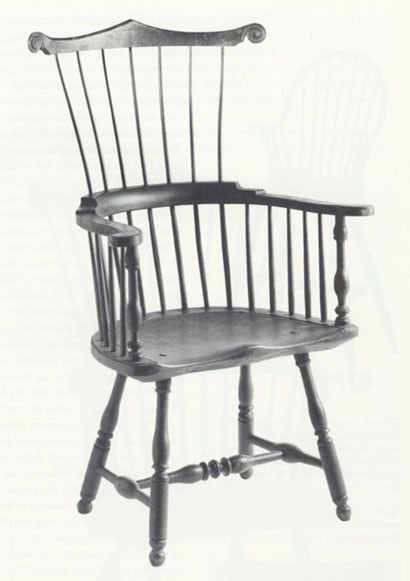
High-back Windsor armchair, eastern United States, probably Pennsylvania, twentieth century in style of ca. 1754–1760. Yellow poplar (seat), oak, hickory, and pear (microanalysis). H. 41 11/16", W. (arms) 25", D. (seat) 15 13/16". (Courtesy, Winterthur Museum, acc. 59.1609.)

Detail of the seat bottom of the chair illustrated in fig. 29. (Photo, Winterthur Museum.)
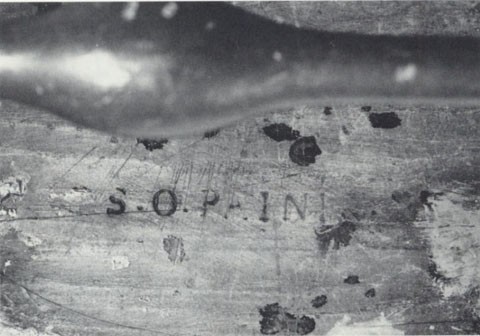
Detail of name brand on seat bottom of low-back Windsor armchair, Philadelphia, Pa., ca. 1760. H. 28 1/4", W. (seat) 24 13/16", D. (seat) 17 1/8". (Courtesy, Independence National Historical Park, Philadelphia; photo, Winterthur Museum)
Problems in Windsor furniture can be difficult to detect. Paint may conceal repairs, new parts, or old elements foreign to the original fabric of a piece of furniture. Collectors, dealers, curators, and furniture historians must be able to recognize and interpret irregularities in structure and design if they are to make wise purchase decisions and accurate object assessments. The detection of problems in Windsor furniture is, first and foremost, a matter of common sense and of training the eye and mind to recognize deviations from standard production. To analyze and understand puzzling features and to reach intelligent conclusions about the integrity of a piece of furniture, it is important for the collector or curator to allow sufficient time to make a thorough examination.
Like most utilitarian furniture, Windsor chairs have suffered from daily use and occasional abuse. Legs have been worn down through constant movement across floors or from exposure to dampness. Stretchers have been worn flat or broken from serving as footrests. Seats have split as a result of hard knocks or internal faults in the wood. Joints have broken under stress and strain. Bows, spindles, and delicate arm rails have cracked from being subjected to abnormal pressure as the wood dried and lost much of its elasticity.
Collectors and curators encounter multiple types and levels of repair and restoration. The most elementary condition is the honest repair, that is, one that retains all the original furniture parts and introduces little or no new material at the damage point. A restoration introduces new elements to replace those that have been broken, badly damaged, or lost, and such restoration work may be minor or major. An alteration involves the addition of a new feature to an existing form or the modification of one or more original element(s) to meet a specific need or condition. As a result, the function of the furniture may be changed slightly or even significantly. Reconstructions are usually a mix of old and new furniture parts to create forms that may be substantially changed in appearance, and sometimes in function, from the original objects. A reproduction is a close copy of a period object made for sale, usually at a popular price. A few reproductions have been created to deceive; others have been deliberately distressed at a later date for the same purpose. Enhanced objects are those made more desirable by the addition of decoration, an unusual feature, such as a headrest extension to a chair back, or documentation to a maker, frequently for fraudulent purposes.
Repairs
Repair work has been part of Windsor chairmaking for more than two centuries. The versatile William Caulton, an upholsterer from London who settled in Williamsburg, Virginia, in 1745, readily announced his ability to make or mend Windsor chairs. Half a century later, specialists working in highly competitive markets attracted customers by promising “neat and durable” repairs executed in a “workmanlike manner” on “the shortest notice” for “reasonable” or “moderate” terms.[1]
A fragile part of a Windsor chair is the bow. Subjected to stress and resin loss during steaming and bending, weakened by holes drilled to socket the spindles, and made brittle as the wood dries out, bows frequently crack and break, especially at the points where holes have been bored and in the areas of greatest compression. Repairers have addressed the problem by various means: gluing, inserting an internal spline, replacing a section of bow with new wood, fastening a wooden or metal brace across the break.
Breaks in the bows of armchairs are particularly common adjacent to the rectangular mortises cut to socket the arms (fig. 1). The wood is thin at these points, and any unusual stress transferred through the arms can cause damage. The illustrated detail from a Philadelphia chair shows a vertical metal brace spanning a horizontal break to secure the joint and provide additional structural strength. The metal piece, which is held by screws, lies on the rear surface of the bow. Braces are often mounted in inconspicuous places and may be inset to conceal the repair.
Over the years, seat cracks and splits have been repaired in various ways, depending upon the severity of the damage. Minor cracks have at times been secured with small, flat pieces of wood called keys set into the surface of the seat crosswise to the break. The shrinkage indicates that a rectangular key inserted in the seat top of a 1790s fan-back side chair made by a Tracy family member in New London County, Connecticut, has been in place a long time. Like the seat, the key is made of chestnut, a wood highly favored in eastern Connecticut and Rhode Island for Windsor chair bottoms. The butterfly-shaped key on the seat bottom of a bow-back chair from the Boston shop of William Seaver and James Frost was part of the original construction, which suggests that a small but repairable crack developed during the shaping process. When the repair was completed, the partners placed their identifying brand on the seat bottom. By chance, part of the Frost surname extends across the butterfly.[2]
Handymen working during the last two centuries have often repaired split seats by simply gluing the break and screwing or nailing a board to the lower surface. Some repairers have chamfered the board edges to minimize the visual intrusion of the extra piece of wood. Another solution is the seat replacement, which requires considerably more skill since it necessitates disassembling the chair. The procedure appears to have been uncommon, although in 1836 partners Thomas J. Moyers and Fleming K. Rich of Wytheville, Virginia, were called upon twice by the same customer to place a new “plank in [the] bottom of [a] chair.” The 25-cent charge for each repair represented about one quarter the cost of a new chair.[3]
An unusual, although not unique, seat repair made with iron clamps to a tall fan-back armchair of southeastern Pennsylvania origin, probably in the late nineteenth or early twentieth century, was perhaps executed in part by a metalsmith. One clamp is visible at the center top of the seat (fig. 2). The crack, which follows the wood grain, runs diagonally from side front to side back. The unusual orientation of the wood fibers is typical of a small group of Philadelphia-area Windsors constructed before the Revolutionary War that have rear seat extensions and bracing spindles in the English fashion. Two other clamps were affixed to the lower surface of the seat near the front and back to complete the repair (fig. 3). The right-angled tips of all the clamps penetrate the wood and are secured from the opposite surface by rivets and square iron washers. An embossed metal tag nailed over one of the clamps on the lower surface identifies the repairer (name obliterated) as a resident of Christiana, Pennsylvania, a small village on the border of Lancaster and Chester counties. The medial stretcher, which is not original, probably was replaced at the time the seat was repaired.
Another uncommon repair employing a metal clamp is one made to a child’s low chair of western Connecticut origin (fig. 4). Probably as a result of hard use, the right back post was loosened at the seat joint, and the up-and-down motion of the loose standard substantially increased the size of the socket, making a normal repair difficult. The metal bar clamp that now secures the joint has a right-angled tip at the top, which passes through the post and is clinched over at the back. The threaded lower end extends through the basswood seat and is held fast by a square bolt and washer.
The crest piece may have been repaired at the same time as the post, since one of the nails holding it in place is also clinched over at the back. Screws were also added to provide further stability to the crest, which otherwise rested on rabbets cut into the post faces, a method borrowed from fancy chair construction. Originally, the top piece would have been held in place by screws inserted only from the back of the posts, countersunk and puttied over before painting. The decoupage decoration, a later addition, was a popular ornamental form from the late nineteenth century.
Restorations
A relatively common nineteenth- and twentieth-century restoration in Windsor furniture is the addition of a modeled or carved block of wood to the lower half of an eighteenth-century scrolled and knuckled handgrip (fig. 5). The unrestored arm terminals in figure 5 illustrate the original construction method: the flat surfaces of the grips and scroll blocks were glued together and the parts further secured with wooden pins or internal metal sprigs (headless brads).
A restoration encountered occasionally is the new lip affixed to the upper back edge of the crest in a nineteenth-century tablet-top chair. Seat rolls may be missing or replaced in other nineteenth-century chairs, since they were simply glued and nailed in place. As the glue dried out and the fasteners became loose, the small attachments fell off and were lost in the course of time.
A common, and usually obvious, seat restoration is a patch to fill in a large, centered hole cut out of the plank in the nineteenth or early twentieth century to accommodate a commode pan. An early reference to this practice is in the Hartford, Connecticut, accounts of Philemon Robbins, who in 1834 undertook a customer’s order for “making hole to large Chair.” Often those who patched the chairs in later years did not contour the replacement disk to follow the original seat modeling, perhaps because a pillow or cushion would conceal the difference. An exception is the craftsman who carefully retrofitted a chair made by Thomas Cotton Hayward of Charlestown, Massachusetts, with a contoured patch. Except under a raking light, modern paint disguises the seat-top repair, although the restoration is plainly visible on the bottom surface.[4]
Replacement stretchers added to furniture in the nineteenth century or later are frequently close imitations or adaptations of the original braces. The modern examiner may find the evidence in disturbed joints or the chronology of paint layers. Other replacements may be more obvious and even use old parts, although making distinctions between the original fabric of a chair and later additions can still pose problems for the collector or curator. Figure 6 illustrates the restoration of two of the three stretchers in a chair, perhaps carried out before the mid-nineteenth century. The medial brace is stylistically different; indeed, the simulated bamboo turning is incompatible with the overall character of the other roundwork. Of the remaining two braces, logic suggests that the bulbous right one is original, since its profile relates more directly to the swelled elements in the legs. An examination of the layers of paint supports this hypothesis and suggests that the original painted surface was bright green over a grayish primer. The paint chronology also confirms that the right front leg, although smaller in diameter than the others, is original. The critical issue is not so much the diameter of the leg as it is the length of the individual elements and the character of the secondary turnings, including the leg tops and the heads of the two balusters.
Replacement stretchers are common because sitters often rested their feet on the chair rounds. Stretcher and chair round are terms used interchangeably in eighteenth- and nineteenth-century accounts. Samuel Douglas of Canton, Connecticut, replaced three rounds in two chairs when he repaired them in 1828. At Deerfield, New Hampshire, True Currier renewed four stretchers in a single chair in the 1830s. Householders frequently had their chairs repainted when repair work was carried out. Solomon Cole of Glastonbury, Connecticut, charged nine pence apiece to paint five chairs in 1799. The new stretcher put in one of them cost six pence.[5]
Pressure could cause legs to crack at the seat joints, and exposure to rough and damp surfaces could wear away the bottoms of legs as far up as the stretchers. When Abraham Low of Freehold, New Jersey, wrote in his accounts, “rep[aired] a winsor chaer with feet & a stritcher” in 1817, it is likely that he replaced the legs in their entirety since contemporary terminology equated feet with legs. Furthermore, it was simpler, less expensive, and more satisfactory to produce completely new turnings than to patch old ones. Preserving as much as possible of the original fabric of a chair was of little concern.[6]
Leg repairs made by late-nineteenth- and twentieth-century woodworkers are of several types. It is fairly easy to detect the open mortise-and-tenon joint, formed by uniting the original leg, which has been slotted at the bottom, and a new lower section cut with a rectangular tenon at the top (fig. 7a). If the repairer instead used a round-tenon joint (fig. 7b), the dowel-like tenon is completely concealed, but a faint circular line is frequently visible at the juncture of the two pieces of wood. A round-tenon joint executed at a natural crease between turned elements (fig. 7c) is often difficult to discern, and it may be stylistic evidence only that suggests a restoration. A leg from a chair of closely related design with similar roundwork above the cylinder (fig. 7d) shows that figure 7c has been restored. The lower legs in figure 7c were missing below the stretchers (which are original), and the restorer wrongly guessed that the chair originally had ball-type feet. The stylistic clue to the problem feet lay in the shortness of the cylinder. (Of further note, the wood grain differs slightly in the new and old work.) Had the legs been restored accurately, the new work might have gone undetected, especially if covered with one or more coats of paint. When a new joint is tight and the wood grain in the original leg and the restoration matches or is concealed by paint, X-ray analysis is often the only way to determine that the legs are pieced out.
Figure 8 illustrates a chair with legs replaced at an early date. All parts of the chair, with the exception of the legs but including the stretchers, were originally finished with a coat of bright, medium green paint over a gray primer. The second coat, which is the base coat on the legs, was a light, chalky blue green.
The question of originality arose because figure 8 is part of a group of unusual Rhode Island cross-stretcher chairs (fig. 9) produced before the revolution and the only one with a peg-like profile below the stretchers. Close comparison of the legs in figures 8 and 9 reveals a striking similarity as far down as the stretchers, suggesting that the repairer had that part of the old leg to copy. Below the stretchers, the turning profiles are completely different, which suggests the original feet had been completely destroyed. A likely explanation is that the feet had been exposed to dry rot, for even severe breakage would not have damaged all the feet beyond recognition nor allowed the stretchers to survive unscathed.
The leg repairs to the low stool with the sizable seat in figures 10 and 11 are unusual. Wallace Nutting, the early twentieth-century furniture connoisseur and author, illustrated the stool in at least three of his publications dating in the 1920s and twice identified the owner as George F. Ives, an early collector from Danbury, Connecticut. The bulk of the Ives collection was housed in the Ives Tavern and Colonial Museum, an eighteenth-century inn originally in Brookfield, Connecticut, re-erected in nearby Danbury. In the “Illustrated Partial List of Items” at the Ives estate sale in 1924, the stool was pictured in the tavern kitchen and identified as item no. 668. The stool sold for forty-five dollars, but whether it entered the Henry Francis du Pont collection at Winterthur directly or at a later date is ambiguous, for it is not mentioned among the list of Ives estate purchases du Pont recorded.[7]
Only two of the stool legs are original. They, along with the seat, retain what is probably the original grain-painted surface in medium and dark brown over pinkish tan. The seat shows evidence of combing, or streaking; the maple legs are mottled and speckled like a pottery glaze.
The three replaced legs are most visible in figure 10. That at the extreme right front was hand whittled of pine, probably by a late-nineteenth-century owner, and is an amazingly good copy given the technique. The left and center front birch legs, possibly early-twentieth-century replacements, are close copies of the original supports in profile and in wear patterns but bear only a light, smeared coat of black paint on the wood. Whether the stool was originally a rare asymmetrical five-legged seat is unclear. Certainly, from the wear at the socket, a fifth leg would appear to have been in place from an early date.
Heavy restoration compromises the integrity of figure 12, a classic early Pennsylvania-type high-back chair long sought by connoisseurs as a cornerstone for their collections. Three features suggest a 1750s date: pronounced incline of the arm rail, attenuated arm posts, and baroque-style medial stretcher. Restoration work starts with the crest, which is a modern replacement colored with a red stain under the present dark varnish. The dimensions from top edge to bottom are greater than usual, the central hump is narrower and higher than common, and the base is almost an inch thick. The ridges of the spiral on the volute-carved ends show almost no wear or damage. Surface aging of the wood, common in old oak (fig. 13), is absent on this crest. Shrinkage, another typical condition that causes the wood of the crest to mold around the spindle tips in surface bulges that are visible or at least apparent to the touch on crest pieces of eighteenth-century chairs (fig. 14), is missing from figure 12.
A diagonal break above the third short spindle at the right rear of the arm rail in figure 12 was repaired with nails, glue, and an outside patch. The rail was restored forward of this point. The first long back spindle adjacent to the repair was broken in two within the rail but not repaired. Both handgrips were restored (fig. 15). The rail ends were sawed off in rabbets (seen from the inside faces), leaving the short edges on the top surface only one-eighth inch forward of the holes drilled for the posts. The grips, each with a flaring side piece, are deeply carved with long grooves to produce knuckled scrolls that were completed by the attachment of separate carved blocks at the lower front edges. Nails hold the rabbets fast, and two large, round wooden pins visible on the inside and outside faces of the rail and handgrips further secure the joints.
In structure and design, the rail ends and handgrips are incorrect for the 1750s. The rail should continue forward on the inside edges to the ends of the grips, with the flaring joined pieces on the outer edges only. Moreover, the knuckled grip is rare in early high-back chairs with D-shape seats and bent arm rails. It was more common on 1760s high-back chairs of rounded-oblong seat and optional on the 1760s sack-back Windsor. As for the design of the handgrips in figure 15, the grooves are abnormally long and deep and positioned too closely together.
The finish on figure 12 suggests that most spindles, short and long, may be replacements, for only one short stick bears traces of the original green paint over a gray primer coat. There is also no evidence of original paint on the right post. That support was likely broken when the rail was cracked through at the rear corner. The new turning is almost an exact copy of the post at the left, an unusual circumstance since variations are generally noted between old and new work, especially in the interpretation of fine elements such as disks, spools, and collars. The feet, which are also restored, show the same attention to turned detail.
The seat plank provided other information about the structural history of the chair. A small, now-plugged hole indicates that the rail was once stabilized by a vertical iron rod between the first and second short spindles behind the right post. (There is no matching hole in the new right rail section.) The many small nail holes and nails on the chamfered edge beneath the sides and back of the seat and the single tacking line on the upper seat edge at the front indicate that the plank was once stuffed.
Each foot bears only a coat of dark varnish, although traces of the original green paint are on other elements of all four legs. The connections between the ring turnings above the feet and the leg cylinders are abrupt and somewhat sharply edged; the crevices lack the typical paint and varnish buildup common at these points. Furthermore, the left front foot is socketed slightly off-center, causing the ring turning to extend somewhat beyond the cylinder at the left side.
The extensive restoration of figure 12 was probably carried out in the early twentieth century. Other repair work was undertaken in 1965 before the true condition of the chair was recognized. A crack in the upper part of the left rear leg was stabilized, and the left front leg was patched in several places.
Alterations
The most common alteration made to Windsors in the nineteenth and twentieth centuries was the addition of rockers. Account books from the late eighteenth century onward are filled with entries for such work, although they do not always distinguish between conversions and replacements of broken or worn rockers. On May 30, 1800, Silas Cheney put rockers on a chair for Tapping Reeve, founder of the Litchfield Law School in western Connecticut, and charged him 1s., or about 16 1/2 cents. Elizur Barnes of Middletown on the Connecticut River charged a customer 75 cents in 1822 to convert a chair for rocking and included in the charge the cost of heightening the back, probably with a headrest, an alteration that suggests the chair was a Windsor. At Erie, Pennsylvania, a chair to be altered was in need of repair when taken to furniture maker George Landon in 1819 for “rockers and foot and stretchers.”.[8]
Surviving chairs that were converted into rockers are usually easy to identify. The chair in figure 16 is typical. The legs are cut off at an odd point (just below the simulated bamboo grooves), stretchers are almost at rocker level, and the attachment method is relatively crude. In the original construction of rockers, the legs are designed and turned to fit the shallower space between the seat and rockers, the stretchers are generally placed several inches above the rockers, and legs and rockers are united by one of three methods: round toes or rectangular tenons in the leg bottoms are socketed into the rockers; thick leg bottoms are slotted to receive slim rockers; or rabbeted leg bottoms are fitted with rockers on the outside or inside surfaces. Original rocker joints are secured by wooden pins, nails, or countersunk screws. Rocker conversion joints are usually rabbeted. In original rabbeted, and sometimes slotted, rocker construction, the long leg extensions adjoining the rockers are generally chamfered at the bottom, providing a neat finish and ensuring smooth rocking. Leg chamfers and rockers in chairs made originally for rocking have the same finish coats found on other parts of the chair, unless repairs or wear have compromised the surfaces.
In addition to the rocker conversion, the chair in figure 16 has undergone both a repair and a restoration. The right back post has been evened off near the bottom and reattached to the post extension that sockets into the seat. The left post has been replaced, and its smooth paint contrasts with the irregular finish on the rest of the chair. Unrestored damage remains at the post-and-crest joints.
A somewhat rare alteration involves converting a chair to a new function by adding a writing leaf to an armchair or even a side chair. Such leafs are generally smaller than customary to allow a user to slip into the confined seating space of the “new” piece of furniture. Sometimes the arm beneath the leaf has been modified to accommodate the writing board. An additional leaf support, usually a shaved stick or a metal brace, may be mounted at an acute angle between the bottom of the leaf and the spindle platform at the perimeter of the seat.
Nineteenth- and twentieth-century alterations carried out because of damage to a piece of furniture are relatively common. Chair backs are particularly vulnerable to mishaps, because as the wood dries out, the back structure loses its elasticity and becomes brittle. Pressure exerted by a sitter or the accidental tipping over of a chair could and did result in cracked or broken posts, bows, and spindles, or damage to the entire top structure. Some owners chose to convert high-back armchairs with broken tops to low-back chairs simply by sawing off the spindles flush with the top of the arm rail. These low-back chairs with slim, steamed and bent arm rails are particularly easy to identify. Chairs made originally with low backs have heavy, three-piece sawed rails to compensate for the pressure of the sitter’s body in this confined area. Chairs with sawed off high backs are structurally unsound; the weight of the sitter is concentrated within the short back rather than being distributed over a taller form.
A side chair that sustained back damage was offered without caveat at auction as long ago as 1926 (fig. 17). A backward fall probably cracked or broke the spindles and posts near the crest. Rather than replace all the vertical parts, the repairer chose to modify the structure by whittling or shaving the upper part of all the elements to produce tips of the correct size for reinsertion into the original crest. The crude tapering of the uprights, including the once-turned back posts forming the ends, is readily apparent. Fan-back side chairs with low backs are uncommon. When they were made, chairmakers fitted them with turned end posts modified in element length to fit the shorter space, much as they reduced the leg height in a rocking chair.[9]
An unusual alteration is pictured in figures 18 and 19. At some point, probably during the late nineteenth century, an owner lowered the height of the chair about one inch but did so with an unorthodox method. He had the rear legs cut off at the bottom and the front legs reworked at the top (fig. 19). The height adjustment of the legs necessitated shifting the side stretchers to minimize the front-to-back slope. Normally, stretchers are positioned an inch or more below the ring turnings in the legs, but the repositioning of the sockets in the back legs necessitated partially piercing the ring turnings. The original holes were plugged.
Even without the alteration, the turned work of figure 18 is out of the ordinary. Although the profiles of all four legs are similar, there is a pronounced difference in the diameter of the turnings of the front and back legs. The intent of the maker must have been to provide additional structural strength at the chair back, where the weight of the sitter concentrates. His concern with structural stress is further expressed in the prominent, ringlike collars at the leg tops (the front ones now removed) immediately adjacent to the seat bottom: rings prevented further penetration of the legs through the plank. The leg features, in combination with the thickly shaped seat and the aberrant character of the bow with its pendent “ears,” identify the chair as the product of a rural craftsman.
Only four multiple-arch, sack-back Windsor settees made in the late eighteenth century are known (fig. 20). Other examples were reproduced in the 1930s by John M. Bair of Abbottstown, Pennsylvania, and Wallace Nutting, who described his as a “triple bow back ten legger.” The chronology of paint layers in figure 20—an aged dark brown over green, both over green on a gray primer—indicates that the replaced parts include the bottoms of both handgrips and part of the undercarriage at the left end: the two rear legs, the two front-to-back stretchers, and the companion medial stretcher. The furniture researcher’s greater challenge in this piece of furniture is understanding what has happened above the base.[10]
Beginning forward of the arm posts, both ends of the seat plank have a series of plugged holes (fig. 21). That both assemblies have the same paint coats as the rest of the settee ruled out restoration of the arms as an explanation and allowed two other questions. Did the chairmaker make a mistake in laying out the upper structure, or did the purchaser request an alteration while the work was in progress? The discovery that the seat is pieced at the front—a longitudinal seam passes through the post sockets and in front of the legs—and the discovery that the seat and the pieced front bear all the paint coats of the other original parts, led to the conclusion that someone decided to remove a piece of the plank, altering the settee some years after its manufacture. Spaced wooden pins, visible along the front edge of the seat, secure the two pieces of wood.
In its present state, the settee plank measures 23 5/8" from front to back, a reduction of about 2" from its original size as determined by the alteration made to the arms. A survey of six other long Windsor seats of late eighteenth-century date indicates that 19 1/4" to 21 1/2" is the usual depth of the settee form; this one is still 2 or more inches deeper than average. Further investigation shows that the arms were shortened at the rear corner joints and that, in the process, an entire spindle unit about 2" in length was removed at each end of the settee. The uprights beneath the arms were relocated in new holes, and the old sockets were plugged up. In its present dimension the seat is at maximum depth for comfortable seating. Two inches more must have made it uncomfortable to several generations of owners before one of them took action. A closely related settee with eight (rather than ten) legs still retains its full depth plank. It has ten short spindles beneath each arm instead of the nine in figure 20.[11]
Reconstructions
The Windsor illustrated in figure 22 is a reconstruction of a chair that began its life as a sack-back armchair, with a bow confining the tops of the long spindles inside an arc springing from the bent arm rail, in the manner of the chairs in figures 5 and 6. The principal evidence for this reconstruction is two plugged holes in the rail, one at each side between the first and second short spindles, where the bow ends were attached. The awkward proportions of the short, narrow back in relation to the breadth of the chair and the fragile, unfinished appearance of the top piece are neither structurally nor aesthetically compatible with the basic chair design. The full swelled short sticks and the slight inward sweep from bottom to top apparent in the end sticks suggest that the long end spindles once arced outward in decided bends within a bow. All parts except the top piece appear to be original to the chair. The long sticks look to be full height or close to full height. There is good compatibility of the turned work below and above the seat, especially in the baluster heads and the profiles of the spools and rings. The large, rounded-oblong contoured seat with its thick, slightly canted sides, together with the turned work, suggest a Connecticut-Rhode Island origin.
Tall stools, because of their size and function, have been subject to considerable wear, stress, and strain. Over time seats have been marred, legs broken, and stretchers worn down. The seat and three of the stretchers in figure 23 are old parts, bearing evidence of several coats of paint under the present outer coat of green, which covers a dark brown finish. The worn state of the early paint coats, however, makes it ambiguous whether all the old parts are original to the same stool. One of the high stretchers and most, if not all, of the legs were considerably worn or broken, because all are new parts. The condition of the stool fits with an entry for a high stool that a Newark, New Jersey, firm took to local chairmaker David Alling in 1838: “To mending seat & putting new legs & rounds to one shop stool.” The high stretcher at the right side in figure 23 exhibits deterioration from use comparable to that in the other three braces, but the wear is artificial: the top left surface is irregular, and the back edge is sharply angular and lacking the soft rounding that resulted from wear on the other braces. The legs are newly turned, and all bear signs of “distress” in the form of rounded nicks, large and small, gouged into the surface with a sharp cutting tool. Large nicks are plainly visible in the left front leg at the points of the bamboo grooves; small nicks fill the long space between the rings.[12]
Reproductions
Although several writing chairs of the pattern illustrated in figure 24 are known, the materials, profiles of the turnings, and the structure are completely unorthodox for the supposed late-eighteenth-century date of this chair. Except for the interior boards of the drawers, which are yellow pine, the chair is made of black walnut, a wood rarely used by American Windsor chairmakers. A small group of cross-stretcher Rhode Island Windsors made before the Revolutionary War was constructed almost entirely of maple (figs. 8, 9). Nathaniel Dominy V of East Hampton, Long Island, made a set of mahogany low-back Windsors in 1794 for a customer who supplied the material from his mahogany grove in Honduras. Walnut Windsors were sold at Philadelphia during the 1760s, but apparently few were made; only one cabriole-leg chair in the English style is known. The modestly curved, thick-bottomed balusters, especially those of the legs, have more the character of late-nineteenth-century than eighteenth-century work (compare them with those in figs. 2, 5–7, 12, 17–18, 20 and 22). The wood surface is rough, and there is no evidence of paint coats beneath the outer black varnish. The stretcher turnings are similar to eighteenth-century braces, however side stretchers with fancy ring turnings are uncommon features on eighteenth-century Windsors.[13]
The construction methods employed in this chair are peculiar by eighteenth-century standards. The arm-rail assembly consists of four units: the two arms, a center-back section that meets the arms at flat butt joints, and a center-back capping piece with short ogee tips. The four pieces of wood are secured with screws from the bottom at the side back joints, a normal procedure in low-back construction, and with pins at the ends of the capping piece. Usually, eighteenth-century low-back rails consist of three pieces of wood only. In Rhode Island construction the arms meet at the center back in a butt joint and are capped by a shaped, ogee-ended top piece. The arms in Philadelphia chairs terminate at the back corners, and the center back section is one solid piece of wood cut with rabbets at the ends to form lap joints.
The seat is made of four boards rather than the usual single thick plank. Two boards form the top surface, and two the bottom, each set held together with two or three butterfly keys. These keys may be seen on the seat bottom (fig. 25) and near the back of the seat top in a line with the brass knob (not original) on the seat drawer. (Other butterfly keys secure the two pieces of the writing leaf on the bottom surface near the inside front edge.) The crosswise joints of the top and bottom seat boards do not coincide, although both are located toward the back of the chair. The two layers of wood are held together with screws, countersunk at spaced intervals around the bottom perimeter of the seat (fig. 25). Originally, the screw holes were covered over with a composition material, most of which has dried up and fallen out. The screws, which have flat tips and exhibit little taper in the shaft, have a tinned finish and date to the mid-nineteenth century or later. The horizontal seam marking the joint between the two board layers is visible across the seat front (fig. 24).
One researcher has suggested that the writing chair and two close mates were made originally for use in a courthouse during the late nineteenth century. The explanation is plausible. At least one chair has a Virginia background, having been recovered near Richmond in the early twentieth century. The walnut tree was common in Virginia, and by the late nineteenth century wide planks would have been difficult to secure and expensive to buy, which would explain why the chairmaker might purchase boards and piece up the seats. Yellow pine as a secondary wood supports a southern provenance.
Though the Virginia writing-arm chair appears to be a straightforward, late-nineteenth-century adaptation of a colonial American design that has been misinterpreted in the twentieth century, there are many eighteenth-century-style reproductions made early in the twentieth century that are creating problems for the unwary. One of the prominent, early-twentieth-century producers of reproduction furniture was Wallace Nutting, who wrote several books on antiques and first issued a catalogue of his reproduction line in 1930. Some of Nutting’s forty-four designs for Windsor furniture are obvious adaptations rather than true copies. Figure 26 is an adaptation that has bold, overstated features. Were this chair to be distressed and painted over many times, the single most revealing feature of its modern provenance would be the seat, which has an exaggerated inward ramp at either side front. Other telltale characteristics are the mechanically precise arms, the sizable crest piece, the exaggerated swells in the spindles, and the trademark turnings—full, oval-bodied roundwork, which represents the epitome of good design, that is present in about half of Nutting’s Windsor production. When viewed, even from a distance, the chair is “too good to be true.”.[14]
One of Nutting’s most successful, and most convincing, eighteenth-century-style Windsor designs is a child’s highchair with a continuous bow (fig. 27). Indeed, this chair, which has been “aged,” passed for many years as a period piece. In some places the light pea green paint is dry and irregular; in other places it is worn away, exposing the shiny patina of the bare wood. Some of the turnings show wear, notably the rings of the medial stretcher, although upon reflection it is obvious that no child’s feet would have reached that far. The seat has several checks and many small nicks on the finished surfaces. The bottom has a lightly tooled appearance. The chance drying out of one of the stretcher-and-leg joints brought the truth to light. The partially exposed stretcher tip looked too white where the paint ended. Further investigation revealed that the end was mechanically formed rather than roughly shaped with a knife (fig. 28), and the flat-bottomed leg socket was hollowed out with a center bit rather than with a round-nosed spoon bit, the premier boring tool of the Windsor chairmaker until the mid-nineteenth century. Nutting’s trademark turnings are present in the highchair, along with the exaggerated spindles. The design is illustrated in his catalogue as no. 210 and priced at forty-two dollars. Even as early as 1930, Nutting commented in general that some of his furniture was being passed off as antique: “A child’s high chair made by me, and sold as new for nineteen dollars, was artificially aged and resold for a cool thousand. Nobody but the maker could have discovered the imposition.”.[15]
Moving from the honest reproduction to the “aged” replica and then to the out-and-out fake is only a few short steps. The early Pennsylvania-type Windsor illustrated in figure 29, which was probably made purely to deceive, has several obvious design and structural faults. Peaked-center crest pieces are uncommon in Windsor design. Wallace Nutting used peaked crests in at least four of his chairs, any one of which could have served as a general model for the independent entrepreneur who made this chair. This thick interpretation has a particularly sharp center point, roughly tooled top edges, and crudely carved volutes with irregular spirals and roughly chiseled hollows.
The small round wooden pins securing the long end and center spindles of the peaked-crest chair are abnormally precise, and the spindles themselves are unusually slender at the tops. The sticks almost seem to be buckling under the weight of the crest (compare the spindles in figs. 12 and 29). The long outer spindles are socketed half an inch or more short of normal placement near the crest scrolls. Below the arm rail tapered spindles vary noticeably in thickness and are crudely shaped in ridges with a drawknife or comparable tool, as is visible under the right arm. The three-piece rail construction with diagonal lap joints at the back corners is correct for a Pennsylvania chair; however, the long ogee-shaped tongues extending onto the arms are not. The upper curves should be longer and more gradual, and the outer tips should be molded in shallow steps (see figs. 5 and 20).[16]
Problems with the turned work are less obvious to the untrained eye. The general plan is correct, but the profiles exhibit subtle variation from the norm (see fig. 12). The upper element in the arm posts is more baluster-like than budlike, and the bulging body of the long baluster is barrel shape rather than round or tear-drop shape, with somewhat angular transitions to the adjacent necks. The long swelling bodies in the leg balusters are more typical of work executed in the 1760s and later. Short, fully rounded swells typify the 1750s (see fig. 12). Saucer-like collars at the baluster tops are incorrect for any period of Pennsylvania work. The feet are simplistically interpreted (compare figs. 2 and 29) and the stretcher turnings are heavier than normal. Furthermore, the paint extends all the way to the bottom tips without any sign of wear.
The upper surface of the seat plank is reasonably well modeled, however the underside lacks any discernable plane marks running lengthwise with the grain of the wood (fig. 30). Planing was a common technique used by Windsor chairmakers to “dress,” or smooth, the bottom of a seat plank. Instead, there are shallow gouge marks at right angles to the wood grain. The seat bottom, which is normally unpainted, has the same gray paint and varnish finish that is found on all the chair parts except the long spindles and the crest. The outer surfaces of the chair are further finished with brownish red paint and varnish.
Another peculiarity of the seat bottom is the presence of open spindle sockets around the back. Normally, the spindle tips are socketed within the plank. Since the short spindles beneath the arms are not exposed and the gray underpaint of the chair is absent from the long spindles and crest, it appears that the original back sticks were also concealed. Either the chair suffered damage to the back soon after being made in the early twentieth century, or the design was altered from low-back to high-back form to make it more salable. In either case, the repairer would have found it easiest to replace the back spindles by opening the sockets at the bottom and tapping out the stumps.
Enhancements
Windsors form the largest group of documented American furniture, yet the number of labeled, stenciled, signed, and branded objects is small. Brands are most numerous and usually identify original makers, although a few can be associated with original and subsequent owners. Some brands are modern additions made with period or new irons to enhance the value or appeal of an object. These marks have been placed on the furniture with intent to deceive.
Windsor brands are usually located on the plank bottom. All those on furniture dating before 1840, and most dating before 1850, bear names formed of letters with serifs (fig. 31). Letter height generally falls into the 3/8" to 5/8" range. The vast majority of craftsmen’s brands includes an initial and a last name. Two-initial names are less common, and last names alone, except for partnerships, are unusual. Occasionally, given names are contracted, such as Ek. for Ezekiel or Ia. for James.
A brand that reads S.O.PAINE in upper-case, serif letters was probably made with a period iron, but its application on three (or more) period Windsor chairs is of twentieth-century date, probably before 1966 when one of the chairs was acquired for an institutional collection (fig. 31). The key to identifying the brand as a modern enhancement lies in the styles and regional characteristics of the chairs it marks. One is a fan-back side chair made in the Connecticut-Rhode Island border region; another is a Rhode Island sack-back armchair. Both date to the 1790s. The third chair is a Philadelphia low-back Windsor with ball-foot legs, made about 1760. All strikes of the brand are positioned near the center back of the seat bottom, where an impression could be made without the interference of legs and stretchers in the framed chair. The current desirability and enhanced value of documented antique furniture is a development of the early twentieth century, when researchers first began to link makers and products.
Problems in Windsor furniture run the gamut from the simple to the complex. Honing individual identification skills requires extensive examination and study of both authentic and compromised pieces of furniture to establish patterns of systematic investigation and to develop the thought processes essential to recognizing, understanding, and interpreting structural compromises in antique Windsors. The connoisseur’s skills are further enhanced through knowledge of styles, construction methods, and regional characteristics. Like other investigative disciplines, the process is one of continued development and refinement.
Advertisements of Richard Caulton in Virginia Gazette (Williamsburg, Va.), November 28–December 5, 1745; Harmon Vosburgh and (?) Childs in Hall’s Wilmington Gazette (Wilmington, N.C.), February 9, 1797; Reuben Sanborn in Columbian Centinel (Boston, Mass.), January 1, 1806; Gilbert Ackerman in Albany Register (Albany, N.Y.), August 31, 1798; Lemuel Adams in Norfolk Herald (Norfolk, Va.), July 11, 1801.
The Tracy family chair is in the Winterthur Museum, Winterthur, Del., acc. 59.1399. The Seaver and Frost chair is privately owned.
Philemon Robbins Account Book, 1833–1836, Connecticut Historical Society, Hartford, Conn. (hereafter cited as CHS). The Hayward chair is privately owned.
John M. Bair, Antiques of the Future (Abbottstown, Pa.: John M. Bair, n.d.), p. 47; Wallace Nutting, General Catalogue, Supreme Edition (1930; reprint ed., Exton, Pa.: Schiffer, 1977), fig. 515, p. 93. Cornucopia, a late-twentieth-century furniture-making shop in Harvard, Mass., is also handcrafting Windsor settees of this pattern.
